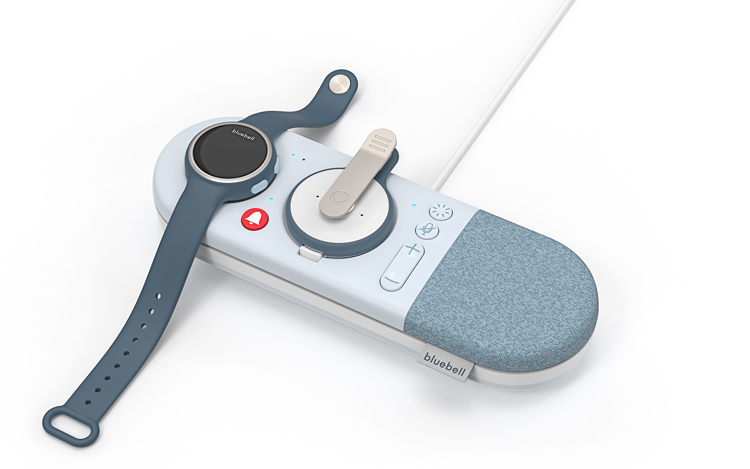This wearable monitoring technology aims to “revolutionise” elderly care
Bluebell InTouch is an extension of the company’s baby monitoring kit, which hopes to provide a “revolution in social care”.
Bluebell InTouch, a wearable technology solution which includes a clip-on monitor, app and hub, aims to help those in elderly care and their carers.
The project is a collaboration from London design studio Tangerine and tech start up Connido. Created in under three weeks, they want to make the system available as soon as possible, though it is still in a trial phase.

It is an extension of Connido’s 2019 product Bluebell, a ‘smart baby monitor’ which uses ‘encrypted mesh technology’, and was then developed with Tangerine’s design team.
During the COVID-19 crisis, the team wanted to turn its attention to the issue of care homes. Together, Tangerine and Connido have “managed to develop a remote continuous monitoring solution concept for the elderly” which aims to “revolutionise how we approach social care”, Tangerine says.
How does it work?

Bluebell InTouch comprises three devices which “work together to provide different levels of support”, Tangerine says. There is a clip-on monitor that is worn by the senior citizen, a hub and an app. An additional wearable can be used by the carer as a wristband or pendant.
The clip-on monitor measures skin temperature, breathing rate and also movement and activity through an accelerometer. It can also detect falls immediately, according to Tangerine. If there is a problem, the device sends an alert to the app and the additional wearable, if it is in use.

The additional wearable can be used within a range of 50 meters. A live-in carer could use it around a home while on breaks or tending to other patients, for example.
The senior citizen can also use the wristband for “self-monitoring” with reminders like when to take medicines or call their family. It can also record sleep patterns and activity levels.
The central hub can function as a night light, which would allow people to move around safely at night, as well as a communication tool through its built-in speakers. Up to 20 wearables can be connected to a single hub.
What could it mean for COVID-19?

The product could have even more relevance during the COVID-19 pandemic. As more people recover from the virus, the “need for post-discharge constant monitoring at home due to ongoing respiratory issues for many patients is becoming clearer,” Tangerine says.
The studio says that hospitals are looking at ways to monitor patients in the community while freeing up hospital beds. “NHS Trusts are rapidly adopting new ways of working, including telehealth and remote monitoring technologies at a rate unheard of so far,” it adds.

A hub could monitor multiple residents at a care home, which would reduce the “risk of cross-infection by decreasing the need for constant face-to-face monitoring”. It might also alert carers to spikes in temperatures or breathing changes that could be missed.
Dr Naveen Sharma, Bluebell’s co-founder and a consultant psychiatrist, tells Design Week that InTouch can integrate with products from other partners, such as video, door sensors or GPS trackers, for example.
However, he stresses the importance of the wearable aspect of the system, which would “help solve the problem of uptake of poor adoption of technology so far in elderly care.”
A holistic approach

While there are plenty of products that aim to cater to elderly care, Tangerine says that they often “focus on single functionality” while InTouch is a “combination of different elements and features, which when used together promises to give family members a real peace of mind”.
Tangerine’s CEO, Martin Darbyshire, says he was inspired by caring for his own elderly mother, who is suffering from vascular dementia. He says: “Bluebell is a tool that had a series of really important benefits that would have helped me better understand my mother’s well-being.
“Looking back it could have enabled us to bring in and brief a doctor fully, earlier in the recovery cycle.”
“Innovative solutions” for elderly care
The product is being trialled at Cross Care Richmond and Kingston upon Thames, a non-profit community care home.The centre’s patron, Vince Cable, says: “I am delighted to see that Crossroads is extending its work in elderly and disability care using new monitoring and reporting technology.
“What is needed is not just money from the government but innovative solutions using technology applicable to the sector, applied by charities which understand care needs and the problems of carers.”
Connido is seeking funding and more testing partners so that it can roll out and scale the product more widely.
-
Post a comment





